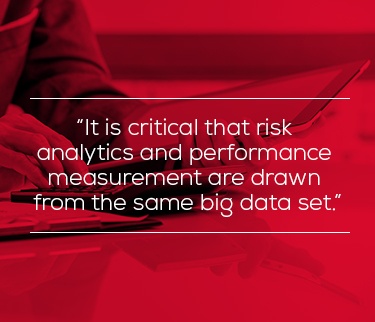Powerful central data sources are now key to placing risk analytics at the centre of asset management businesses.
One reason for this is the complex risk matrix that asset managers now need to factor into their investment models. As long ago as 2013 EY’s Risk Management for Asset Management survey listed no less than 20 top risk categories that were chosen by their respondents:

Regulation
The sheer number and variety of risks that affect portfolios from differing aspects makes risk management highly challenging (and talented risk managers in strong demand). Significantly, regulatory risk topped the list of asset managers’ concerns in the EY survey.
{{cta(‘ac6116e0-3f05-4cc8-a5b6-309ed30d8fef’)}}
In the intervening years since this survey was carried out, further regulations have rolled off the production line and more will surely follow. While estimating and managing risk has become highly complex, regulators require complete look through of both data and the models that produce and analyze it.
 As a result, it is critical that risk analytics and performance measurement are drawn from the same big data set. In addition, consistency between risk and performance reporting is an absolute priority.
As a result, it is critical that risk analytics and performance measurement are drawn from the same big data set. In addition, consistency between risk and performance reporting is an absolute priority.
It follows then that risk managers now have a central role to play to meet the needs of the front office. Damian Handzy, StatPro’s Global Head of Risk puts it this way:
“Today, it’s essential for asset managers to be able to model and calculate risk in a way that matches the investment process and produces timely and accurate data.
“It’s also important to take that data and turn it into actionable information using the right analytics and visualization and then share it quickly to the people that need it, no matter where they are, or what device they happen to be using.”
Collaboration
So collaboration between risk and performance has become central to asset management operations. In turn, risk is no longer a department hidden from view whose role seems to be to inhibit, rather than support investment decisions.
On the contrary, risk analytics, based upon timely data and made available to the front office through self-service reporting, determines what not to allocate funds to. This saves time in chasing lost investment causes that will not pass risk testing – such as regulatory scrutiny of one sort or another.
Equally important, however, is the buy-side view. Clients have become highly sensitized to risk since 2007. Return is a constant requirement of course, but explanations of risks taken – based upon rigorous, well-communicated analytics – is a primary client-reporting requirement that has to support and transparently justify asset allocation. Risk reporting has therefore taken center stage in the communication between asset manager and client.
Risk, the front office and the asset management business
The front office has traditionally consumed and digested massive amounts of data. This includes market data, reference data and transactional information, for example. This situation has not changed. Indeed the number of data sources has multiplied. The front office remains the data consumer but now is able to view it through the prism of risk analytics focussed on centralized information.
The power of the technology that handles this data essentially provides the platform for the central processes of the business as a whole. Throughout, risk is fundamental to the processing of external as well as internal data for the purposes of the investment management enterprise.
In today’s trading environment, the importance of risk analytics is paramount for every activity across the business.
Takeaways
- Risk analytics are central to performance
- The risk matrix has become increasingly complex
- Big data provides the raw material for both risk analytics and performance reporting
- Risk and performance go hand-in-hand – especially in light of regulatory scrutiny…
- …and, crucially, client sensitivity to risk
{{cta(‘bff04473-5d7d-4110-ae71-df16ed720376’)}}